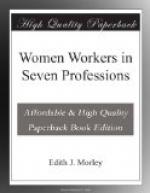Trained 22,134 30,410 2,260 1810 Untrained 9,060 33,121 539 1598
These figures show that of men teachers, 70 per cent. in England and 81 per cent. in Wales are trained, while of women teachers only 46 per cent. in England and 51 per cent. in Wales are trained.
These statistics are indicative of the urgent need for total abolition of uncertificated and supplementary teachers, since the recognition of these grades offers a direct incentive to girls just to bridge over the period between leaving school and getting married, without qualifying even for what ought to be regarded as the lowest ranks of the profession. This fact is at once realised, when one contrasts the percentage of women teachers who are untrained, viz., 54 per cent, in England, 49 per cent, in Wales, with the corresponding figures for men teachers, viz., 30 per cent, in England and 29 per cent, in Wales.
Every candidate for teachership, who has passed through a Training College, is required by the Board of Education to serve in a recognised school—a woman for five out of the first eight years after leaving College; a man for seven out of the first ten years after leaving College—or pay the whole or part of the Government grant in respect of College training. But, notwithstanding this agreement, enforceable under Act of Parliament,[5] the Board of Education neither takes steps to find employment for such candidates in the State schools of the country, nor admits any responsibility on its part for the conditions under which teachers are employed. By the Education Act of 1902, local authorities, of which there are 318, were made chiefly responsible for the work of education, and it is these local authorities who lay down the conditions of appointment.
This refusal by the Board of Education of responsibility for appointments and conditions of appointment to teaching posts, leaves it for local authorities to fix scales of salaries, and to decide such questions as, for example, whether married women teachers shall be employed. The grave effect of this state of things on the economic interests of the teachers of the country cannot be too much emphasised, having regard to the fact that local authorities are bodies composed mainly of men elected on a rate-saving principle.
The salaries paid to bursars and student teachers are insufficient to cover charges for maintenance, clothes, books, etc. Speaking generally, a quite substantial sum must also be found during each year of the collegiate course, for college expenses and for board and lodging during vacations, so that a candidate’s parents must hold themselves financially responsible for her during the various stages of her training, except in so far as the cost is covered by scholarship and maintenance grants. Women candidates are in this respect far worse off than their male colleagues, as, at every stage of their training,




